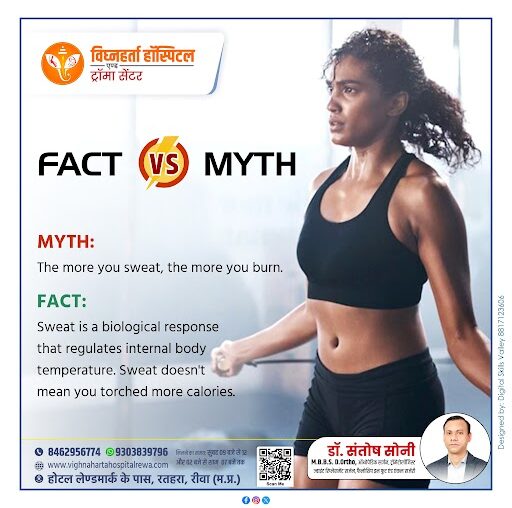When it comes to fitness and weight loss, there are numerous myths that can mislead people on their journey to a healthier lifestyle. One common misconception is the belief that “the more you sweat, the more fat you burn.” Let’s separate fact from fiction and understand the truth behind sweat and calorie burning.
Myth: The more you sweat, the more you burn.
Fact: Sweat is a biological response that regulates internal body temperature.
Sweating is the body’s natural cooling mechanism. When you exercise or experience heat, your body releases sweat to keep your temperature stable. However, the amount you sweat is not directly linked to the number of calories burned or fat loss.
Understanding Sweat
– Why Do We Sweat?
Sweating occurs when sweat glands release moisture (a mix of water and salt) onto the skin. As it evaporates, it cools the body down.
– What Affects Sweating?
The intensity of sweating varies from person to person and is influenced by:
— Genetics
— Climate and humidity
— Fitness level
— Type and intensity of exercise
Calorie Burn vs. Sweat
– Calorie Burn: When you exercise, your body burns calories to fuel your muscles. This process depends on factors such as workout intensity, duration, and body composition — not how much you sweat.
– Sweat: Just because you’re sweating heavily doesn’t mean you’re burning more calories. For example, a hot yoga session may make you sweat a lot due to the heated environment, but it doesn’t necessarily burn more calories than a brisk walk in cool weather.
Breaking the Myth
Relying on sweat as a measure of your workout’s effectiveness can be misleading. Here’s why:
– People can sweat profusely even without intense physical activity, such as in a sauna or during a hot day.
– Those who don’t sweat much (like in air-conditioned gyms) can still burn a significant number of calories during a rigorous workout.
How to Track Effective Workouts
Instead of focusing on sweat, track your progress using these methods:
1. Heart Rate: Monitor your heart rate to ensure you’re exercising in the optimal range for fat burning or endurance training.
2. Calories Burned: Use fitness apps or devices to estimate calorie expenditure based on activity.
3. Performance Metrics: Track improvements in strength, stamina, or flexibility over time.
4. Consistency: Regular and consistent exercise, combined with a balanced diet, is the key to sustainable weight loss.
Final Thoughts
While sweat is an important part of your body’s cooling system, it’s not a direct indicator of calories burned or fat loss. To achieve your fitness goals, focus on maintaining a healthy routine with proper exercise, diet, and hydration.
If you’re looking for personalized fitness or health advice, consult with experts like Dr. Santosh Soni at Vighnaharta Hospital Trauma Center. They offer a wide range of medical services to help you lead a healthier life.
Contact Information
– Phone: 91 8462956774
– Website: https://vighnahartahospitalrewa.com/
– Location: Near Hotel Landmark, Rewa, Madhya Pradesh
– E-mail : [email protected]
Break free from fitness myths and embrace scientifically backed practices for a healthier, happier you!




